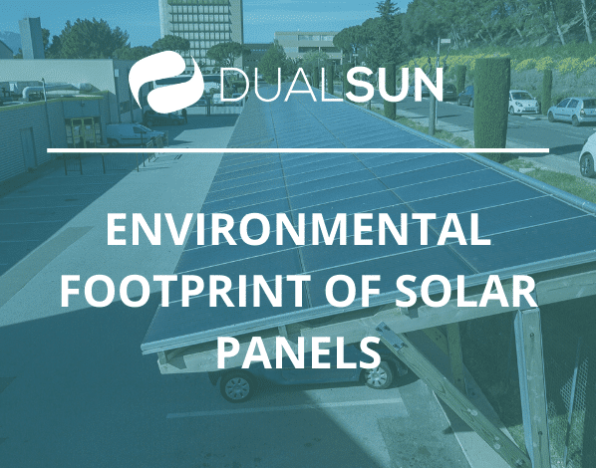What is the environmental impact of a photovoltaic, thermal or hybrid solar panel and how it is it measured? There are several environmental impact assessment methods out there, the best-known ones being the Carbon Footprint® (“Bilan Carbone®” in French) the Life-Cycle Assessment (LCA), and the Simplified Carbon Evaluation (“Évaluation Carbone Simplifiée” in French). The environmental impact of solar technology is minimal, particularly when compared to other solutions such as nuclear technology.
This article explains the environmental impact of solar panels and the 3 methods used to calculate it.
—
SUMMARY
- The environmental impact of solar panels
- The Carbon Footprint® of the solar panel
- The Life Cycle Assessment (LCA)
- The Simplified Carbon Evaluation (Évaluation Carbone Simplifiée – ECS)
The environmental impact of solar panels
Nowadays, measuring the environmental impact of photovoltaic or thermal solar panels is mandatory. This is primarily to ensure adequate life cycle management and compliance with standards, but is also necessary for panel waste management and eligibility to participate in calls for tenders.
Solar panels have a very limited impact on the environment. Contrary to popular belief, no “rare earth elements” are used in manufacturing solar panels.
For reference, the term “rare earth elements” designates 17 mineral materials with exceptional properties that have become strategic materials ever since the digital boom. Ever since, the extraction and processing of rare earth elements has been accused of being highly polluting.

Solar panels are made of crystalline silicon, an element extracted from sand or quartz. Like the glass in the solar panel, this part of the panel is also 100% recyclable.
Moreover, solar panels generate more energy than is used to manufacture them. For instance, the environmental break-even point (EPBT) of a solar panel is 2.5 years in Northern Europe and 1.5 years in Southern Europe. The numbers represent a ratio between the total energy required in manufacturing a panel and the energy it generates annually.
Its environmental break-even point ranks highest among clean energy generation solutions. The environmental impact of the solar panel is minimal, particularly so when compared to other solutions such as nuclear power.
For more information on the environmental impact of photovoltaic technology, consult the report by the Fraunhofer Institute for Solar Energy Systems.
[et_bloom_inline optin_id=”optin_14″]
The Carbon Footprint ® of the solar panel
The Carbon Footprint® is a single-criteria analysis based uniquely on greenhouse gas emissions. It is the most widespread carbon-assessing method for products in France.
Initially developed by the ADEME (French Environment and Energy Management Agency), it was then taken up by the Carbon Footprint Association. The Term “Bilan Carbone” (Carbon Footprint) has since come into general use in France. According to article 26 of the French Law “Grenelle II”, the Carbon Footprint analysis is compulsory in certain cases, such as for companies with over 500 employees.
As of October 2011, the Carbon Footprint® is a registered trademark designating a specific tool and carbon assessment method. The use of the Carbon Footprint® trademark is therefore reserved to the members and licensees of the Carbon Footprint Association.
The Life Cycle Assessment (LCA)
This method is widely used in Europe and has been standardized internationally as ISO 14040/44.
The Lifecycle Assessment is a multi-criteria analysis used to estimate the environmental impact of a product or a service throughout its entire life cycle.
As such, the Life Cycle Assessment includes the carbon footprint as well as other environmental impacts such as eutrophication, eco-toxicity, etc.
The objective of the Life Cycle Assessment is to highlight the dominant environmental impacts and identify which elements and processes pose major threats to the environment in order to then work on reducing their impact.
Let us have a look at the Life Cycle Assessment and calculation of a solar panel’s primary energy.
Primary energy of a solar panel
The primary energy of a photovoltaic system is used to calculate the environmental break-even point by substituting the amount of energy usually required to manufacture the product with the photovoltaic output that the product generates.
There is general consensus that it takes an average of 1.5 to 2.5 years for a photovoltaic system to generate as much energy as was used to manufacture it. Any variations depend on the amount of sunshine absorbed, and therefore the location of the installation.
Thanks to technological improvements, the environmental impact of solar panels is decreasing as the efficiency of the cells is increasing. This is also owing to system designers who continuously strive to optimize output.
Recycling the solar panel
Another important aspect of the LCA concerns the recycling of solar panels. This process is handled very well nowadays. As a matter of fact, 94.7% of photovoltaic panels are recycled. Read our article on recycling solar panels with the PV CYCLE France Association.
[et_bloom_inline optin_id=”optin_14″]
The Simplified Carbon Evaluation (Évaluation Carbone Simplifiée – ECS)
The third method we will describe is a French, single-criteria method known as the Simplified Carbon Evaluation.
It was developed by the French Energy Regulation Commission (CRE). As its name indicates, the Simplified Carbon Evaluation is a simplified study (as opposed to the LCA or the Carbon Footprint).
The Simplified Carbon Evaluation makes it easy to calculate the greenhouse gas emissions resulting from the manufacturing of photovoltaic solar panels (except the frame). The calculation begins from the extraction of the raw materials and leads right up to the assembly of the panel.
The quantity of greenhouse gas emissions per kWp* (G) is calculated with the following formula:

The Simplified Carbon Evaluation is compulsory in order participate in CRE calls for tenders with projects over 100 kWc. The panel is graded according to the result of the Simplified Carbon Evaluation and this grade represents up to 33% of a project’s final grade. Therefore, the environmental impact associated with the manufacturing phase of a panel is very important in calls for tenders.
The Simplified Carbon Evaluation of the DualSun hybrid solar panel
Together with the engineering consultancy firm SOLSTYCE, we applied this method to our very own hybrid solar panel.
The results of the evaluation demonstrate that our hybrid panel emits 435.3 kgCO2 per kWp (value for the 1st generation DualSun hybrid panel).

Verbatim: “The Simplified Carbon Evaluation of the DualSun hybrid panel is very good, among the best on the market. This demonstrates that its manufacturing process requires low energy consumption and is very well thought-out.” Nicolas Planchenault, SOLSTYCE engineer, Simplified Carbon Evaluation and LCA expert
The Simplified Carbon Evaluation results obtained by Dualsun were excellent and we are doing our utmost to minimize our environmental impact.
For further reading:

Aucun commentaire pour le moment